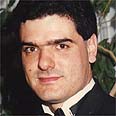
| THINK-ISRAEL |
| HOME | September-October 2010 Featured Stories | Background Information | News On The Web |
On October 12, 2000, two non-combatant Israelis were lynched and brutally beaten and mutilated by a Palestinian mob in Ramallah, Samaria. Yosef Avrahami, aged 38, was the father of three; Vadim Novesche, the other victim, was a 33 year-old newly-wed.

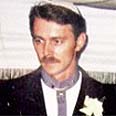
On October 12, 2000, some Israelis lost their way and drove into Ramallah.[2]
On that day the world witnessed Arab-Islamic animalism on display, shameless inhumane revelations, by "average" Arab-Palestinians and their official police.
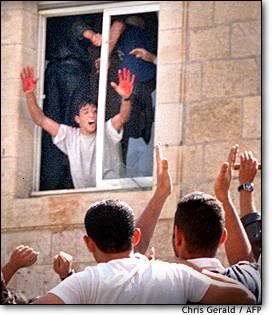
A British photographer, Mark Seager, working on a pictorial study of Palestinian refugees stumbled on the event after the initial attack in the Ramallah police station. He did not witness that aspect. He subsequently described what he did see in The Sunday Telegraph, a respected British daily newspaper. The following is an extract.[3]
|
"I had arrived in Ramallah at about 10.30 in the morning and was getting into a taxi on the main road to go to Nablus, where there was to be a funeral that I wanted to film, when all of a sudden there came a big crowd of Palestinians shouting and running down the hill from the police station. I got out of the car to see what was happening and saw that they were dragging something behind them. Within moments they were in front of me and, to my horror, I saw that it was a body, a man they were dragging by the feet. The lower part of his body was on fire and the upper part had been shot at, and the head beaten so badly that it was a pulp, like a red jelly. I thought he was a soldier because I could see the remains of the khaki trousers and boots. My God, I thought, they've killed this guy. He was dead, he must have been dead, but they were still beating him, madly, kicking his head. They were like animals. They were just a few feet in front of me and I could see everything. Instinctively, I reached for my camera. I was composing the picture when I was punched in the face by a Palestinian. Another Palestinian pointed right at me shouting 'no picture, no picture!', while another guy hit me in the face and said 'give me your film!' I tried to get the film out but they were all grabbing me and the one guy just pulled the camera off me and smashed it to the floor. I knew I had lost the chance to take the photograph that would have made me famous and I had lost my favourite lens that I'd used all over the world, but I didn't care. I was scared for my life. At the same time, the guy that looked like a soldier was being beaten and the crowd was getting angrier and angrier, shouting Allah akbar — God is great. They were dragging the dead man around the street like a cat toying with a mouse. It was the most horrible thing that I have ever seen and I have reported from Congo, Kosovo, many bad places. In Kosovo, I saw Serbs beating an Albanian but it wasn't like this. There was such hatred, such unbelievable hatred and anger distorting their faces. The worst thing was that I realised the anger that they were directing at me was the same as that which they'd had toward the soldier before dragging him from the police station and killing him. Somehow I escaped and ran and ran not knowing where I was going. I never saw the other guy they killed, the one they threw out of the window. 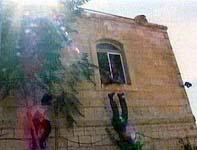
I thought that I'd got to know the Palestinians well. I've made six trips this year and had been going to Ramallah every day for the past 16 days. I thought they were kind, hospitable people. I know they are not all like this and I'm a very forgiving person but I'll never forget this. It was murder of the most barbaric kind. When I think about it, I see that man's head, all smashed. I know that I'll have nightmares for the rest of my life." |
The BBC version below is somewhat more informative than many other accounts that denied, whitewashed/justified or blamed the Jews. Hanan Ashrawi in her role of defender of the PLO has managed over the years to do all three:[4]
BBC accurately depicted some of what happened:
"Another horrific escalation on the streets of Ramallah ... Lynch mob's brutal attack. Crowd abused body of Israeli ... Photographs show some of the doomed men were dressed in civilian clothes."Gruesome scenes were visible through an open window as the mob savagely beat and stabbed two or possibly three of the soldiers to death.
Then a body was thrown from an upstairs window. The frenzied crowd clapped and cheered as more blows were rained down on the lifeless figure by the crowd outside.
On the other hand, BBC inserted justifications for this with remarks such as these:
Anger had been brewing for the last two weeks which have witnessed the funerals of about 100 Arabs, nearly two dozen of them children, who have been killed in the violent uprising against Israeli occupation forces.
But this outburst of fury apparently stemmed from rumours circulating through the mob that the captives belonged to the feared and hated undercover units of the Israeli army which dress as Arabs and strike in the heart of Palestinian towns.
Earlier this week, the badly beaten body of a Palestinian, Issam Hamad, was found dumped on the outskirts of Ramallah. Palestinians blamed his death on Israeli settlers.
BBC neglected to mention that Israel was being subjected to the Second Intifada started by Yasir Arafat two weeks before. BBC neglected to mention that Israeli killings weren't wholesale but meticulous targetting of mob leaders, who, as usual, were often shielded by women and children. "Eye witness" accounts describe Hamad's body as badly beaten and other accounts add that his face was scarred with burns, implying he was tortured. This is the MO of Arab treatment of those who collaborate with Israel, but the Arabs are sure that it must have been done by Jews, so why look elsewhere?
The take-home lesson was: the Arabs had a right to show their anger. Their behavior had nothing to do with their "blood lust" culture.
Since this lynching, the official Palestinian broadcasting stations
have made every effort to hide the horrible pictures which were shown around
the world.
According to reporters' evidence on the scene, not only did the
Palestinian police not protect the two men slaughtered while in their custody
in the Ramallah police station, but they also tried to prevent foreign
journalists in the area around the building from filming the incident.
Despite the attempts to distance reports, an Italian television crew
managed to film several scenes.
The following is an ad published in the Al Hayat Al Jadidah newspaper, considered the main newspaper of the Palestinian Authority. The ad, probably paid for, is
evidence of the double standard which has come to characterize much of the
reporting of the recent violence in the territories.
Note that the brutal lynching is described merely as "the events".
|
Special Clarification by the Italian Representative of RAI, the Official Italian Television Station My dear friends in Palestine. We congratulate you and think that it is our duty to put you in the picture (of the events) of what happened on October 12 in Ramallah. One of the private Italian television stations which competes with us (and not the official Italian television station RAI) filmed the events; that station filmed the events. Afterwards Israeli Television broadcast the pictures, as taken from one of the Italian stations, and thus the public impression was created as if we (RAI) took these pictures. We emphasize to all of you that the events did not happen this way, because we always respect (will continue to respect) the journalistic procedures with the Palestinian Authority for (journalistic) work in Palestine and we are credible in our precise work. We thank you for your trust, and you can be sure that this is not our way of acting. We do not (will not) do such a thing. Please accept our dear blessings.
Original ad in Al Hayat Al Jadidah: 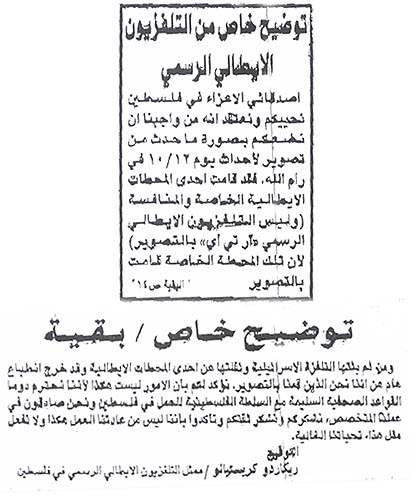
|
In "Betraying Truth: The Abuse Of Journalistic Ethics In Middle East Reporting," Kenneth Lasson writes[11]
Journalistic integrity demands adherence to several basic and interrelated principles: factual accuracy; reporting in a reasonably balanced (that is, comprehensive) manner; and understanding the context of events and code words used to define them. Moreover, the Western journalist's traditional search for objectivity and balance should be underscored and highlighted whenever it is threatened by intimidation or otherwise compromised in authoritarian societies.In the Mideast, however, these rules have been substantially fogged by what has come to be known as "moral equivalency" — that is, reporting the positions of each side in a conflict as if they were of equal merit — effectively obfuscating any distinction between aggressor and victim. Although the quest for balance can reflect a genuine concern for accuracy, in this case there is ample evidence to suggest that it may also be caused by fear and, bias, as well as by the fatigue factor that sets in during coverage of such a long and protracted conflict.
Over much of the past decade the Palestinian Authority has adeptly depicted its constituents as dispossessed and oppressed — effectively eliciting widespread sympathy by way of effective sound bites and poignant images. "You cannot shoot our children and get away with it?" exclaims PA spokeswoman Hanan Ashwrawi in perfect English. Negotiator Saeb Erekat decries the "daily massacre of Palestinians by Israel."
The message thus becomes, How can Israel want peace when its mighty army sends tanks against impoverished stone-throwers?
Israel, on the other hand, has often assumed a defensive position — that its military actions have been solely to physical provocations and out of the need for security. It has been slow to present in clear and simple ways what many consider its best arguments: that it has been under siege from Arab countries and movements for more than half a century. It has been unable to focus attention on how the Palestinian leadership employs both its educational system and its communications media as tools of incitement; how rock-throwing teenagers sometimes serve as camouflage for machine-gun-firing militia and how PA ambulances are used as command-and-control vehicles to deliver troops and weapons to demonstration sites.
This next article describes how Palestinians manipulate the foreign press into suppressing unfavorable coverage. The press largely relies on local reporters/translators/cameramen for actual coverage; these people are readily co-opted by the Arab leadership. It was written by Judy Lash Balint, a Jerusalem-based writer and journalist whose articles have appeared in many publications worldwide, including the Christian Science Monitor, Jerusalem Post and Seattle Times. She conducted an in-depth survey of media representatives in preparation of this insightful report. She discovered a complex pattern of intimidation at work that has exerted a profound influence on journalists and what they report.[12]
WND Editor's note: Despite the increasing violence and terror in the five-month-old "intifada" — yesterday's suicide bombing by a Palestinian terrorist killed three Israelis and wounded 60 — much of the international news coverage throughout this troubled period has displayed an openly pro-Palestinian slant. "Media frightened into self-censorship:
Part 1: The aftermath of the filming of the infamous Ramallah lynching last October.JERUSALEM — Journalists and the Palestinian Authority have what might euphemistically be called a strained relationship. The independent Committee to Protect Journalists, which monitors abuses against the press and promotes press freedom around the world, reports: "In the nearly seven years since the Palestinian National Authority assumed control over parts of the West Bank and Gaza, Chairman Yasser Arafat and his multi-layered security apparatus have muzzled local press critics via arbitrary arrests, threats, physical abuse and the closure of media outlets. Over the years, the Arafat regime has managed to frighten most Palestinian journalists into self-censorship." There's no reason to suspect that foreign correspondents — who were notoriously hounded in Beirut 20 years ago by the PNA's forerunner, the PLO — are not exercising the same kind of self-censorship today, compromising fair and objective coverage of the current situation. Still, the most effective clamp on the truth is the peer group — the homogenized ideology of the press corps where independent thinking continues to require courage and fortitude. In a region where the media has in many ways shaped the conflict, the combination of fear and lockstep thinking on the part of its protagonists does not bode well for its resolution. Ramallah: never the same The lynching of two Israeli reservists in Ramallah last October proved to be a watershed in coverage of the new intifada. Up until that point, most Western journalists traveled wherever they wanted to in their quest to convey the essence of Arab violence and Israeli reaction. Sky TV News reporter Chris Roberts says that at the outset of the violence, the PA welcomed reporters with open arms. "They wanted us to show 12-year-olds being killed," he explains. But after the lynch, when PA operatives did their best to confiscate and destroy tape of the grisly event and Israel Defense Forces used the images to target and arrest the perpetrators, Palestinians have sometimes vented their hostility toward the U.S by harassing and intimidating Western correspondents. "Post-Ramallah, where all goodwill was lost, I'm a lot more sensitive about going places," Roberts admits. Even people like Ahmed Budeiri, a bright, 20-something Arab stringer for ABC-TV, acknowledges that Ramallah was "really dangerous for foreigners," after the lynch. According to firsthand reports, a Polish television crew was surrounded by Palestinian security forces, beaten and relieved of their film of the lynching. But most of the TV cameramen were Palestinians. Given PA intimidation of Palestinian journalists, it's not surprising that almost all of them, except for one working for the Arabic news channel Al-Jazeera and another shooter for the independent Italian station, RTI, meekly handed over their film. Nasser Atta, a Palestinian producer with the ABC News network, was outside the Ramallah police station with a camera crew as the bloody scene unfolded. Appearing the next day on ABC's "Nightline," he told host Ted Koppel that crowd members had assaulted his team to stop them from filming the action. "I saw how the youth tried to prevented [sic] — prevented my crew from shooting this footage. My cameraman was beaten," Atta said. A British photographer, Mark Seager wrote in London's Sunday Telegraph Oct. 22: "I was composing the picture when I was punched in the face by a Palestinian. Another Palestinian pointed right at me, shouting 'no picture, no pictures,' while another guy hit me in the face and said, 'Give me your film.' One guy just pulled the camera from me and smashed it to the floor." Most reporters acknowledge that the PA openly confiscated TV footage and still photos of the lynching. But some, like Canadian Broadcasting Company's Neil Macdonald, asked PA Security chief Jibril Rajoub about the matter and were told that no tape was seized. Others, like the New York Times' William Orme, came to their own conclusion that while the mob that attacked journalists did include some uniformed Palestinian police officers, "no one is suggesting that it was PA policy. It was not an official order." The film that did escape the clutches of the PA police made its way to TV screens around the world in an unorthodox way. According to Gideon Meir, deputy director general for public affairs at the Israeli Foreign Ministry, the Israeli Embassy in Rome was able to secure the video from the independent Italian RTI TV station, and within six hours of the gruesome event, the images were received in Jerusalem. The Italians released it without charge, said Meir. TVNewsweb, a website for TV editors and correspondents, reported the transmission of the footage a little differently. "Two tapes are spirited away and reappear in Jerusalem one hour later. Al-Jazeera's tape is offered for sale at US$1,000 per minute, but it's shot shakily from far away and lacks impact. The RTI tape is extremely graphic. Meanwhile, veteran Italian TV reporter Riccardo Cristiano had just been released from the hospital where he spent more than a week recovering from injuries he received when he was beaten up in Jaffa while covering the riots started by Israeli Arabs. Cristiano's nose was broken, his cheek gashed, and he almost lost the use of his right eye. The Italian government TV channel reporter went back to work the day before the lynching. According to CBC's Macdonald, Cristiano, "a very pacifist guy," was traumatized by the Jaffa attack. When he received death threats the day after the Ramallah events, presumably from Palestinians who mistakenly associated his TV channel with the damning lynching footage, Macdonald says Cristiano penned a letter in English to a Palestinian journalist friend at Al Hayat Al Jedida newspaper, assuring the colleague that his station had nothing to do with the filming nor would he ever violate journalistic ethics by transmitting film to an embassy or government office. On Monday, Oct. 16, a version of the letter appeared in Arabic on the front page of the paper. Cristiano lost his Israeli press credentials and was recalled to Rome. The RTI correspondent was spirited out of the country for her own safety after the Israel Defense Force used freeze-frames of her film to nab six of the perpetrators in undercover raids. This reporter traveled to Rome to meet Cristiano last December. The tall, gray-haired and mustachioed, soft-spoken man acknowledges he's a leftist, but in his quest for justice for those whom he perceives as oppressed, he feels he's following in the footsteps of his father, renowned Italian artist Paolo Cristiano. The senior Cristiano was a member of the Italian resistance who spent three years in a series of Nazi death camps. He weighed 60 pounds when he returned home. Riccardo says his father is mortified by those who accuse his son of being anti-Semitic. "The only thing he wanted to do when he came to visit me in Israel was visit Yad Vashem," Riccardo quietly said. Recently, Cristiano met with the head of the Jewish council in Venice to explain his actions and gain his support. The Al Hayat letter became a significant political issue in Italy because Cristiano worked for the government station, and his letter was perceived to have endangered the life of a reporter from the independent channel operated by former Prime Minister Silvio Berlusconi of Italy's center-right opposition. Berlusconi's party is critical of support for the Palestinians on the part of the government-controlled media. Over the course of several interviews, Cristiano was careful to talk only about what has happened to his life in the intervening months, not the details of his controversial letter. Even though he does not have a job, he is technically still employed while he awaits a disciplinary hearing that will determine his future as a journalist. His October letter was unauthorized, and he can't afford to be accused of another unauthorized action such as an interview explaining his actions. Interestingly, Orme recalls that in a telephone conversation with Cristiano the day the letter appeared in Al Hayat, the Italian reporter verified and even defended its contents, telling Orme that he was concerned for the safety of his staff. Cristiano's plight does provide a certain insight into the journalistic fraternity of those covering the Middle East. Like the other reporters who were beaten up by Palestinians over the past few months, Cristiano has no rage against their violent tactics. Neither does he expect much from the PA. He relates how his crew was filming a bodyguard of PA Jerusalem Affairs minister Faisal Husseini who slapped someone at a garden party at Orient House, the PA Jerusalem headquarters. Another guard came over and erased the film. Cristiano, the deputy bureau chief, complained. The next day, Husseini sent an apology and all was forgiven. While Cristiano has obvious sympathy for the Palestinian cause, he is not anti-Israel. He speaks of his special interest in the Armenians and views both Israel and the Palestinians as "nations under trauma." But until his name is cleared, Cristiano continues to be a fallen man. "My friends think I'm in this mood because I lost my job in Jerusalem," he said sadly, "but the reality is that I lost my honor and credibility from myself and my heritage." Part 2: Writing with a Pro-Palestinian slant is the price of access and safety in covering Mideast conflictWND Editor's note: Shortly after the outbreak of the current Palestinian "intifada" or uprising, National Public Radio's Jennifer Ludden reported: "Today is a repeat of the last three days ... You've got this Goliath of an Israeli army with guns. In some places yesterday they used armored tanks. There were battle helicopters buzzing overhead. At one point in the Gaza strip yesterday, Israeli soldiers fired an anti-tank missile. All this directed at young kids with stones." JERUSALEM — Extensive interviews with correspondents based here, as well as those who have flown in to cover the ever-widening Mideast crisis, reveal a highly complex journalistic reality that is anything but conducive to unbiased reporting. Within the Jerusalem-based press corps of several hundred reporters, there are varying degrees of knowledge and understanding of the situation. After the first week of the violence, many media outlets reassigned journalists from other posts to assist their colleagues in Jerusalem. In some cases, these people did have previous experience covering the Middle East, but in most instances, the journalists landed in their bureaus at Jerusalem Capital Studios with little background on the history, geography or political landscape of the area. To whom do they turn for a crash course on the Israel-Arab conflict? By and large it's other journalists who provide them with an overview of the lay of the land. Georges Malbrunot, correspondent for France's Le Matin daily paper, for example, calls the BBC his "living Bible." Thus, as Fiamma Nirenstein, the Israel correspondent for Italy's La Stampa newspaper points out, "the extraordinary informal power of the media — iconoclastic, sporty, ironic, virtually all of one mind," comes into play. In fact, the best factual reporting from the new intifada has come from the few correspondents with background in the area who jetted in for a few weeks and left before they became tainted with the political correctness required of the resident media set. Jack Kelley of USA Today, for example, filed a couple of outstanding stories during his limited days in Jerusalem. In one piece, he described his experience riding along in an Israel Defense Force jeep patrolling the volatile Ayosh Junction outside Ramallah. Eyewitness accounts of the violent provocation by Arab youth and the decision-making of the equally youthful IDF troops provided an accurate insight into the challenging situation. But for most of the American Colony Hotel-based Western correspondents, there are certain "given" assumptions that provide the backdrop for all their coverage. Topping the list is the notion that Palestinians are engaged in a noble struggle for independence and Israeli oppressors are using their might and muscle to stand in their way. Journalists arrive at this view based both on experiences in their own native lands as standard-bearers for minority rights and other liberal causes, but also as a result of their reliance on local assistance here in Israel. Since very few of the foreign correspondents in Israel are fluent in Hebrew or Arabic, they rely on a network of local sources as well as the service of "fixers" — locals who can "fix" situations for them. Currently, some 400 Palestinian Authority residents are in possession of Israel Government Press Office credentials. Much of the current conflict is raging in Area A (under full Palestinian Authority control), so it is not surprising that the fixers are generally young U.S.-educated Palestinians who know how to operate in PA territory and who introduce the journalists to their circle of acquaintances. Most of these Palestinian "fixers" also know Hebrew, and their GPO credentials generally enable them to navigate quite well throughout Israel without security intimidation. In contrast to this informal networking on the Palestinian side, correspondents generally get the Israeli point of view from official sources. The Government Press Office — currently a one-man operation — is charged with informing journalists of briefings with government officials and coordinating coverage of the comings and goings of the prime minister and the Cabinet. The Foreign Ministry and the IDF spokesman's office provide access to IDF commanders and other top officials. "We suffer from a deluge of information," notes Washington Post bureau chief Lee Hockstader. Others, like Phil Reeves of London's Independent newspaper, acknowledge that Israel provides excellent entree to senior officials in contrast to more limited and guarded access to PA higher-ups. Chris Roberts of the UK-based Sky TV News service calls the Israeli official PR effort "a well-oiled machine." But there is little Israeli effort to establish personal relationships with journalists to provide them with a non-propagandistic, man-on-the-street view of events. The effects of this vacuum are easy to discern. When Ted Koppel taped a "Nightline" show at the East Jerusalem YMCA in the early days of this intifada, several smartly dressed, attractive, young English-speaking Arabs made sure they saved a chair for New York Times bureau chief Deborah Sontag. When Sontag arrived, she was greeted with kisses by one of the young women in the group. In contrast, an older Israeli audience member who went over to introduce himself was given a cursory nod by Sontag, absorbed in conversation with her chic friends. The influence of Arab TV crew members is obvious even in the offices of some news outlets. At the ABC-TV studio, for instance, the only map hanging in the office is dated March 2000 and displays the title, "Palestine." A reporter for a Canadian paper explains how knowledge of Arabic can be a very useful thing. In Beit Jalla last December, the IDF sent a missile into the Church of St. Nicholas, causing little damage. The PA called a news conference there. In English, the local clergy said, "Oh, this is so terrible. See what the Israelis are doing." In Arabic, they were overheard saying to each other: "That m----- f----- Arafat. Why can't he keep his guns away. He'll get us all killed." But most journalists speak very little Arabic, so they use Palestinian crews, which creates another problem. The harassment of Palestinian journalists critical of Yasser Arafat is well documented by Israeli and Palestinian human rights organizations. The Committee to Protect Journalists wrote in an Oct. 20, 2000 report: "Major newspapers routinely avoid coverage of issues such as high-level PA corruption and mismanagement, human rights abuses by security forces, and any reporting that might cast Arafat in a negative light. Moreover, the major Palestinian dailies all enjoy cozy relations with the PA, further blunting their editorial edge." Coercion, abduction and violence by PA security chief Jibril Rijoub's forces is a fact of life for east Jerusalem Arabs. Who knows under what pressure Palestinians working for Western news organizations operate, or to whom they report? In effect, little seems to have changed since Zev Chafets wrote in his book, "Double Vision," about Western journalists' coverage of the Lebanese war of the early 1980s. (Just substitute American Colony for Commodore and Jerusalem for Beirut.) Wrote Chafets: "In conformity with the PLO-dependent security system, Western reporters ghettoized themselves and became, in effect, accomplices to their own isolation and supervision. They clustered around the Palestinian-run Commodore (Hotel) where they knew their movements, contacts and outgoing communications would be monitored. Some of those with separate offices in the city found that they needed local Palestinian employees in order to establish contacts and guide them through the complexities of life in Beirut. These assistants were, in many cases, subject to the discipline of the PLO; and if the organization was circumspect in its dealing with most of the foreign reporters, it could afford to be far less so in its demands on its fellow Palestinians or Lebanese Moslems. Even reporters aware of the fact that their local employees might be a conduit to PLO intelligence were loath to give them up; in many cases, such people were an invaluable buffer." One of those reporters detained by the PLO in Beirut in 1981 left Lebanon in a hurry a short while later, after publishing an article confirming the harassment of journalists in Beirut. John Kifner is still a New York Times correspondent. Kifner arrived in Jerusalem for a short stint in December, covering the current intifada. Despite his extensive experience with the PLO, Kifner declined to be interviewed for this article, citing "touchy personnel issues" with Times bureau chief Sontag, who happened to be out of the country at the time of the request. Some journalists simply dismiss concern over PA attempts at censorship. Acknowledging "famous incidents to suppress stories" here, The Independent's Reeves nevertheless notes that: "Everyone does this. The Brits did it in Northern Ireland." Others categorically deny that intimidation by the PA takes place at all. Speaking for the Foreign Press Association, the New York Times' William Orme (Sontag's husband) says that he knows of no documented incidents of official PA harassment or intimidation. The physical attacks against journalists were all street violence perpetrated by individuals who are acting out their feelings against Americans, Orme states. The head of the Foreign Press Association doesn't necessarily agree. In an article in Haaretz (Oct. 19), FPA chair Howard Goller says that, speaking generally, one could say that there are many pressures on foreign journalists. "On certain occasions, Israeli soldiers or PA representatives have tried to stop us from filming certain events," Goller confirms. Orme's remark is eerily reminiscent of NBC editorialist John Chancellor, who observed at the height of the Lebanon War in 1982: "There is no censorship in Beirut. ..." This despite the murder by the PLO of seven foreign journalists in West Beirut between 1976-1981, according to Edouard George, then-senior editor of Beirut's French-language daily L'Orion Du Jour, and the departure from the city of several Western journalists because of PLO threats. The wire services that provide reporting to papers around the world have not been immune from PA heat, either. A few months ago, the Palestinian Union of Journalists jumped into the act. A letter signed by the PUJ appeared in the PA daily Al Hayyat, condemning the Jerusalem Associated Press bureau's coverage of the conflict. The letter threatened that if the bureau did not change its coverage, the group would adopt "all necessary measures against AP staffers." Jerusalem AP representatives refuse to discuss the matter. According to one member of the Jerusalem press corps, the Reuters bureau in Gaza, staffed largely by Palestinian journalists, was closed down briefly. It seems that PA attempts to stifle media criticism are successful due to the intertwining of Western news-gathering organizations with Palestinians subject to the long hand of the PA. Just a few days after the January executions in Nablus (Shechem) of two Palestinians accused of collaborating with Israel, Palestinian security service agents arrested a photographer who filmed one of the two grisly events without PA authorization. Only three photographers working for the PA were allowed to cover the execution. Other reporters and cameramen were barred from the police station where the execution took place. The detained photographer, Majadi el-Arabid, works with both foreign and Israeli news agencies. Despite these tactics, Orme rejects out of hand the comparison with PLO tactics in Beirut, calling that period "a completely irrelevant episode." Equating the PLO in Beirut with the PA today is "inaccurate," Orme claims. "There, they were a guerrilla army fighting a war and might have had reason to block access to the press. Here, we're talking about certain areas under Israeli military control and other areas under PA control, so there are formal government entities." Palestinian threats against journalists are analogous to settlers who threaten TV crews too, he argues. It is misleading to suggest that there is a PA policy of intimidation, Orme concludes, citing the "hundreds of complaints" his organization has received about Israeli government handling of the press — everything from limited access to shooting of reporters to the restrictions against Israeli nationals being allowed into certain areas. In contrast, "only a handful" of journalists have filed complaints against the PA. "There is no self-censorship," either, Orme states categorically. In contrast, one Hebrew-speaking British newspaper correspondent who requested anonymity noted that the self-censorship exercised by reporters in the Middle East today is understood and tacitly accepted by the home offices of their news bureaus. "They turn a blind eye to it because they know they couldn't function at all without the help of the locals," he said. The British journalist cited a November incident illustrating his point. Western TV crews who filmed West Bank protests against Egyptian President Mubarak were forced to turn over their film to Palestinian security forces at a checkpoint while Egyptian intelligence officials looked on. According to the British source, the incident went unreported. This same reporter claims that Palestinian police have confiscated BBC footage in Bethlehem and explains that many Western TV reporters exercise self-censorship in PA-controlled areas in order not to run into confiscation problems. Journalists who have been physically attacked by Arabs are obviously even more acutely attuned to where they go and what they say. Chicago Tribune reporter Hugh Dellios suffered a severe beating in Jerusalem's Old City on the eighth day of the riots. Dellios and a colleague from the Toronto Star who was with him that day now "think good and hard about where we're going." Dellios reckons that the treatment he received was because he was singled out as a Westerner in the angry crowd milling about looking for targets. "Some women started screaming, 'He's an American,'" Dellios recalls. "They knew we were journalists, but they suspected that I was an Israeli provocateur." This same suspicion was directed at Wall Street Journal Middle East correspondent Steven Glain. Twice, while covering the riots from the rooftops of Jerusalem's Old City, Arab youths asked Glain if he was Jewish. Veteran Canadian Broadcasting Company foreign correspondent Neil Macdonald tells of a recent incident in Nablus (Shechem) where he was surrounded by a group of young Arab rioters who suspected the journalist and his crew were Israeli undercover forces. "I'm a 6'6" WASP," Macdonald says. But the gang persisted, even after his Palestinian fixer vouched for his journalistic credentials. Demonstrating his close ties with local Arab leaders, Macdonald called a Nablus politician who sent someone from his office "to make them disappear." A similar event occurred a few weeks later in El Khader, a known Hamas stronghold, where "10,000 very angry people" were attending a funeral. "The Fatah activists were getting pretty nervous and aggressive and kept on asking 'who are you?'" Macdonald recounts. The CBC correspondent has completed two and a half years of a four-year stint here. He claims that the threats don't impact much on his coverage, but he relates several anecdotes of physical violence against other journalists. He's learned a little Arabic, not much Hebrew. Asked what is the greatest constraint on full coverage of the intifada, Macdonald says it's the danger of being caught in the crossfire. "I don't trust that the IDF won't shoot me because I'm a reporter," he declares. "I think of the IDF as a democratic institution but that's not to say there aren't people from Kiryat Arba (a suburb of Hebron) in the IDF." |
The IDF pursued some 15 men involved in the massacre and orgy. The last one was caught September 26, 2007.
|
"Ramallah-Lynch Terrorist Nabbed." [13]
IDF soldiers have arrested the last of the Palestinian Authority (PA) terrorists responsible for the brutal lynching of two IDF reservists in Ramallah seven years ago. Soldiers apprehended 36-year-old Tanzim terrorist Hayman Zaben in Shechem early Wednesday. Zaben was one of those responsible for bludgeoning to death IDF reservists Vadim Nurzitz and Yossi Avrahami in a PA police station in Ramallah in October, 2000. The two Israeli reserve soldiers had accidentally entered PA-controlled Ramallah, just six miles north of Jerusalem, and were arrested by PA police. It was once they were in custody that the lynch occurred. TV images of the lynching show a body of one of the two Israelis being tossed from the police station window to a mob of local Arabs who beat the soldiers' bodies with anything they could get their hands on. The mob is seen waving body parts in the air and proudly displaying their blood-soaked hands to their comrades. Zaben the Seventeenth Arrest Zaben is the seventeenth terrorist to be arrested in the murder, though a huge mob had assembled and took part. In 2001, fifteen men were arrested in connection to the lynching, including Aziz Salha, the man photographed displaying his blood-soaked hands out the window of the PA police station. From the nearby village of Deir Jarir, he was in Ramallah that day and admitted running to the police station once he heard that Jews had been apprehended. He said he took part in strangling the men to death while others beat them. Fatah Tanzim terrorist Muhammad Howara was also arrested in 2001. He admitted to entering the police station and stabbing the men. He is from the village of Mazra'a Kabalya. In 2005, Mohamed Abu Ida was arrested. He was the PA policeman/terrorist who brought the men to the station, where he handed them over to the lynch mob. He then joined the mob in murdering the men. He had escaped to Egypt following the incident and was arrested upon his return to Gaza, where he lived. (He was brought up in the Jabaliya refugee camp in the Gaza Strip.) Another terrorist involved was Nasser Abu Hamiyad. He had been released from an Israeli prison as a good-will gesture in the context of the Oslo Accords and later took part in the Ramallah lynch. Two years later he also organized an attack on Jerusalem's Neve Yaakov neighborhood, murdering a female police officer and wounding 10. On March 5, 2002, he orchestrated an attack on the Seafood Market in Tel Aviv, murdering Israelis Eliyahu Dahan and Yossi Havi, and wounding 31. |
The Goldstone report made much of the fact that in the Cast Lead incursion into Gaza, the IDF could sometimes not avoid hitting the worman and children who acted as human shields for the terrorists. But nothing was said about how the Palestinian arabs deliberately and cynically target women and children whenever possible. For example, they send missiles into Sderot in the early morning as the children set out for school.
It is easy to come by pictures said to be of Palestinian children subjected to bullets, missiles and schrapnel. They are circulated on the internet almost like a subset of child porn. There's no information about where, who, when, how. Some of the pictures are recycled and claim to be a result of the latest clash. Israelis tend not to publish photos of their dead. Here are two exceptions.[14]
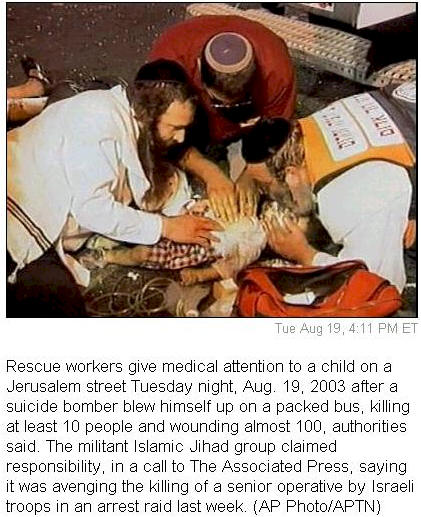
On March 26, 2001, an Arab sniper shot this beautiful baby, Shalhevet Tehlya Pas of Hebron, in the head. The investigation made clear that the sniper had aimed directly at her head, as she was held in her father's arms. Her father Yitzhak, 24, was moderately wounded in the legs. The family was standing at the entrance to the Avraham Avinu neighborhood in Jerusalem.[15]
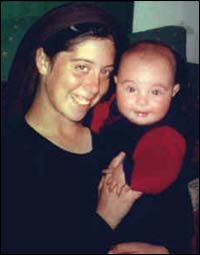
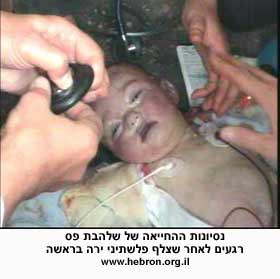
"In 2003, nearly two years later [after the Ramallah massacre], Arab parents in Gaza cheered again when their little children dressed up as members of the Ramallah lynch mob, complete with hands painted blood red, for a kindergarten graduation ceremony..."[16]
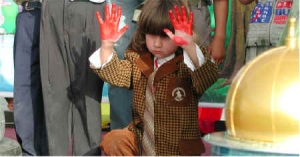
The Israeli newspaper Maariv includes a photo of a young Palestinian girl at her kindergarten graduation holding up hands dipped in red paint in emulation of the scene at the lynching of two Jewish reservists in Ramallah, where the murderers showed their bloody hands to the crowd. The children also burned an Israeli flag and paraded with plastic rifles.[17]
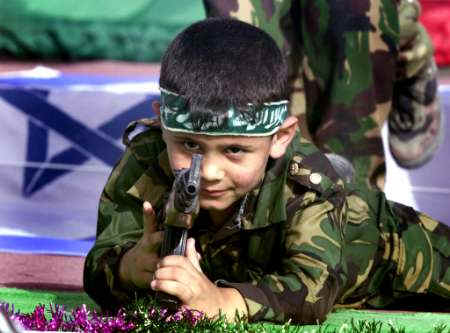
|
"This is the Enemy"[18]
Nick Berg, an American from Philadelphia, was kidnapped and tortuously beheaded by Arabs in Iraq sometime in May. The murderers filmed the deed and proudly displayed the victim's severed head in front of him. [...] The week before, after shooting at Tali Hatuel's car, causing it to skid and stop, Arab terrorists walked over to the vehicle to finish the occupants off. They looked at the heavily pregnant mother and her four no-doubt frightened girls; the youngest was two years old. And then shot them all. At point-blank range. With sadistic satisfaction, they systematically murdered Tali Hatuel and her unborn son, as well as all of Tali's daughters: Hila, age 11, Hadar, 9, Roni, 7, and two-year-old Meirav. Among the participants at the funerals of the Hatuel family members was President of Israel Moshe Katzav. He said, "This day of blood will be engraved in our history. An earthquake has happened. No one in the world can stand apathetically by in the face of these acts by such evil people. Where are those who speak in the name of Allah In Fallujah in March, crowds of townspeople dragged four American civilians out of their vehicles, shot or beat them to death, mutilated their bodies, dragged them through the streets, suspended them from a bridge and burned them. And they danced and cheered. With their children. In Ramallah in 2000, two Israeli soldiers were kidnapped, beaten, stabbed countless times, had their eyes gouged out, and were literally disemboweled and dismembered by an Arab lynch mob. The people — and I use the term loosely — who carried out the initial beatings threw one of the victims down to the waiting mob, where his face was further crushed with stones, feet, fists and even a heavy metal window frame. One Jew was set on fire and dragged along the street as Arab onlookers danced and cheered. Some of the butchers celebrated their crimes with the victims' internal organs. One of the killers, famously captured on film, proudly displayed his blood-soaked hands to the cheering Ramallah crowd. 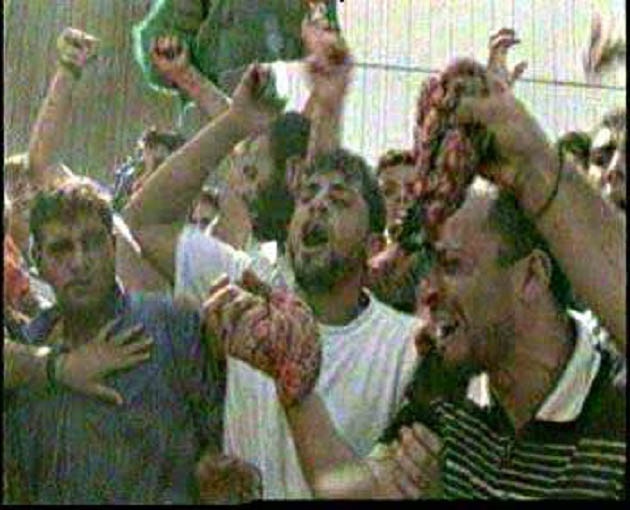
During the lynch of the two IDF soldiers who had taken a wrong
turn into Ramallah, one of the Arab murderers paused in his
savage beating to answer a cell phone belonging to one of the dying
soldiers. He told the worried voice on the
other end of the line, "We are killing your husband."
|
Footnotes
[1] http://www.freerepublic.com/focus/bloggers/2560537/posts.
Much of the text appeared, was quoted or was cited on the New Republic
Blog on July 28, 2010. It was posted by PRePublic
(http://www.freerepublic.com/~prepublic/). Think-Israel added some new
material, revisions, rearrangements and updates.
[2] http://www.freerepublic.com/focus/bloggers/2560537/posts
[3] http://www.jewishvirtuallibrary.org/jsource/History/lynchwit.html
[4] http://www.campus-watch.org/article/id/69
[5] Jordon Times 29Oct2000
[6] Jordan Times, October 29, 2000
[7] PA's Voice of Palestine Sept. 9, 2001
[8] Translation provided by Prof. Michael Widlanski of Hebrew University and the IMRA News Agency.
[9] http://news.bbc.co.uk/2/hi/middle_east/969778.stm
[10] "http://www.mfa.gov.il/MFA/MFAArchive/2000_2009/2000/10/Coverage%20of%20Oct%2012%20Lynch%20in%20Ramallah%20by%20Italian%20TV
[11] http://works.bepress.com/kenneth_lasson/3/ (2009)
[12] Part 1 appeared March 5, 2001 in World Net Daily
(http://www.wnd.com/?pageId=8374)
[13] http://www.israelnationalnews.com/News/News.aspx/123789
[14] http://www.chayas.com/media.htm
[15] http://www.education.gov.il/children/page_23.htm
[16] http://www.israelnationalnews.com/Articles/Article.aspx/3732"
[17] http://www.likud.nl/extr209.html
[18] http://www.israelnationalnews.com/Articles/Article.aspx/3732
[19]From http://www.freerepublic.com/focus/bloggers/2560537/posts
Video of the Ramallah Lynching
Thanks are due American1627 for sending in the article to Think-Israel.
| HOME | September-October 2010 Featured Stories | Background Information | News On The Web |